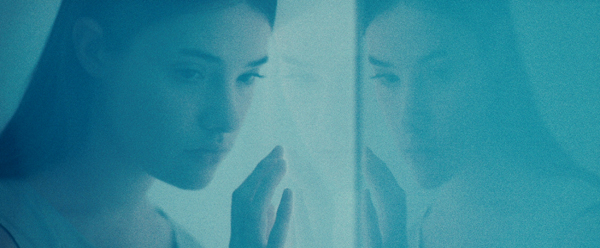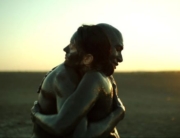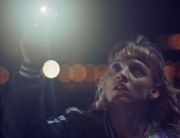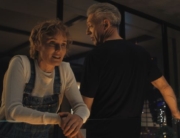
Eva Allan as Elena (Magnet Releasing)
I saw Beyond the Black Rainbow weeks ago, and decided perhaps against my better judgment not to take notes as I watched the film. I attended it with a friend who saw Panos Cosmatos’ debut feature at the Tribeca Film Festival last year, where it had the same kind of reception as Stanley Kubrick’s 2001: A Space Odyssey. Half the audience walked out before the film ended, while everyone else stayed in rapt attention. In retrospect, it wasn’t a bad decision since the film now lingers in my mind like a hazy, affectionate-but-dark-as-hell dream (but not a nightmare). It’s science fiction, but it works on the mind much more like a bizarre spell cast by a wizard from another planet.
I wish I could explain the plot very easily, but Beyond the Black Rainbow mostly refuses the conventional. This doesn’t mean that it doesn’t have a very specific setting, in a way. Like Donnie Darko, it takes place in the 1980s (1983 to be exact, footage of President Reagan graces a TV screen at one point), and also in an alternate reality, where the Arboria Institute conducts psychic evaluations. Dr. Barry Nyle (a breakthrough performance by Michael Rogers) treats a young woman (Eva Allan), who may be mentally disturbed or have some kind of psychic craziness that the doctor can’t quite penetrate with his mind… or, he can penetrate it and is torturing her (it took me a ways into the movie to figure it out). Meanwhile, every interaction is seen on video monitors in a control booth. The sets are slick and metallic, designed not unlike 2001’s oppressively white and banal futuristic sets.
The doctor seems to be a villain, tinkering with her and (we assume) other patients’ minds in the goal of finding… what I’m not sure. But it must be nefarious since he, too, is going insane over time, spurred on by an acid-fueled mind-bender that he took back in the mid-1960s, seen in an especially disturbing and disorientating black-and-white flashback.
If some of these descriptions sound obtuse, it might be on purpose on the part of Cosmatos. His film is not driven by story, though there is one there if you look for it, but by mood and some subliminal level of consciousness, more like in music. The film cleverly opens with a commercial for the Arboria Institute, shot like a late ‘70’s/early ‘80’s orientation video (like for the Dharma Initiative on the TV show Lost), but it doesn’t quite prepare the audience for what this film will be, which is an unabashedly experimental trip into an alternate-fourth-dimensional “un”-reality.
Beyond the Black Rainbow does have emotional substance involving the doctor and his bond with an older, dying mentor who needs injections to stay alive, but it’s really about its singular style, how at times bright red, purple, and green glowing colors and smoke may fill a room, and how characters take… their time… speaking (think Lynch’s Eraserhead). Cosmatos is not afraid to keep the camera rolling, and he doesn’t cut where another director would. His rhythm makes the viewing experience hypnotic, and sometimes I had to wonder if the director realized how he was using deadpan humor with some of his actors (especially between the long pauses the doctor and his wife take before responding to one another).
Watching the film’s trailer can somewhat prepare you for the experience, but it only represents a sliver of the eccentric daring on display, in which Cosmatos positions himself as the new Alejandro Jodorowsky. I don’t know if Beyond the Black Rainbow is a great film, but it’s absolutely unforgettable as an audio-visual sensory torrent.






Leave A Comment